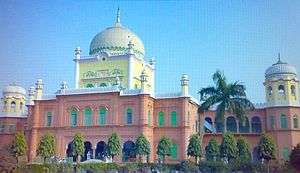Jamiah Darul Uloom Zahedan
| Type | Islamic university |
|---|---|
| Established | 1971[1] |
| Chancellor | Maulana Abdul Hameed |
| Vice-Chancellor | Maulana Abdul Ghani Badri |
Academic staff | 65 (Total 2011) |
Administrative staff | 90 (Total 2011) |
| Students | More than 1200 (2011) |
| Location | Zahedan, Sistan and Baluchestan, Iran |
| Campus | Omar Khayyam Road, Zahedan, Iran |
| Website | http://web.archive.org/web/20110127073528/http://english.sunnionline.us:80/Darululoom-Zahedan |
Jamiah Darul Uloom Zahedan (دارالعلوم زاهدان in Persian)is the largest and highest seat of Deobandis in Iran. Maulana Abdul Azeez, son of Mojahid Shaikh Abdullah, founded the Jamiah.
The Jamiah started its education activities in 1971 for the first time along with around 60 to 80 students and only 6 teachers in the new building of Darul Uloom on Khayyam Road.[2] A good number of students studying at Jamiah Darul Uloom Zahedan.
Education pattern
| Part of a series on |
| The Deobandi movement |
|---|
 Darul Uloom Deoband, India |
| Ideology and influences |
| Founders and key figures |
| Notable institutions |
| Centres (Markaz) of Tabligh |
| Associated Organizations |
| Militant Organisations |
The Jamiah has divided its education system into seven stages. These stages are given below along with years each stage requires:
- Primary Stage: two years
- Junior Stage: two years
- General Secondary Stage: two years
- Special Courses Stage: two years
- Higher Level(BA) Stage: four years
- Alameya (MA) Stage: two years
- Specialization in Fiqh (Islamic jurisprudence): two years
The total term of study besides having primary certificate of any government school, including two-year of specialization, is 16 years.
Department and administrative divisions
The Jamiah has following departments and divisions:
Dar-ul-Iftaa, Specialization in Islamic Jurisprudence, Tafseer and Da'wah, Darulqadha and Tahkeem, Girls School, Hefz-e-Quran section, Tajweed section, Da'wat and guidance centre, Office for Students' Affairs, Central Library, Translation and Research Centre, Publication, Fiqh Academy of Ahlus-Sunnah, Institute of Arabic Language and Islamic Studies, Union of Islamic schools of Balochistan, SunniOnline Website, Medical Centre, Office for Islamic Institutes, etc.
Grand Makki Mosque in Zahedan, Iran, the largest mosque of the Sunnis in Iran situated next to the Seminary.
Publication
The Jamiah is publishing the Neday Islam Magazine.[3] The Jamiah has also published many articles.[4]
Dozens of Islamic books have been published by Darululoom Zahedan via Siddiqi Publicationa and its Translation & Research Centre in Persian and Arabic languages, mostly.
See also
- Madrasah
- Deobandi
- Darul Uloom Deoband
- Darul Uloom Karachi
- Darul Uloom London
- Al-Jamiatul Ahlia Darul Ulum Moinul Islam
- Jamia Uloom ul Islamia